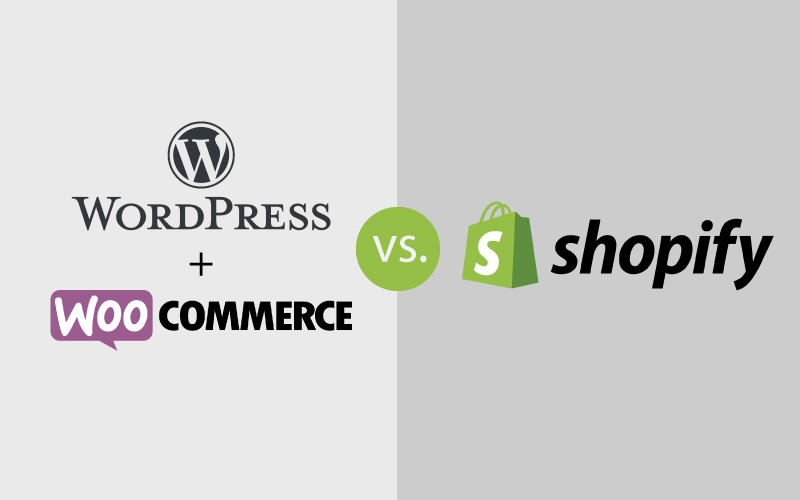WordPress vs Shopify
Why would one compare WordPress vs Shopify? To answer an on-going question that a lot of companies find themselves asking – ‘Which is better for an e-commerce website or an online store?’
Continue reading for a full examination of each platform and their key features. We will also include reasons why you might choose one over the other for your e-commerce website or online store.
By the end of this blog post, you should have a better idea of which platform will serve your needs best. (We’re also here too if you need help. Please do not hesitate to reach out to us!).
Let’s start with an overview of both platforms.
What is Shopify?
Shopify is an online application that was specifically designed to allow merchants to build and launch an e-commerce website.
It provides templates that can be customized, to a degree, to meet your brand identity and requirements. Also, it also allows you to sell both physical and digital products on the platform.
Shopify is considered a hosted solution, which means everything runs on the company’s servers and not your own. The idea is that everything you need to build and run your store happens ‘out of the box.’ Or at least most of it – more on this later.
Shopify is a software as a service (‘SaaS’) tool – this means that you don’t own a copy of the software, but pay a monthly fee to use it instead. Being a web application, it runs in the cloud; this means that as long as you have access to a web browser and the internet, you can manage your store from anywhere.
Introducing Shopify: A Hosted, Customizable E-commerce Platform
WordPress (WordPress.org) is a free and open-source content management system (CMS) It boasts a plugin architecture and a template system that has surpassed many of its competitors. It is known for its ease of use, is most associated with blogging, and it is used by more than 60 million websites,[1] including 33.6% of the top 10 million websites as of April 2019,[2][3] WordPress is the most popular website management system in use.[4] Best of all, there are very few limitations with what you can do on WordPress. Typical uses include more traditional mailing lists, databases, forums, media galleries, business websites, digital resumes, portfolios, and online e-commerce websites.
What are the target audiences for Shopify and WordPress?
It is fair to say that ‘Shopify’s main target is users who want to create an e-commerce store but do not have the technical know-how to do so. WordPress technically has that in common with Shopify. However, it takes a bit more of educating the client on the pros and cons of each. There are plenty of business cases to choose WordPress over Shopify (or Wix for that matter.)
One of the things that WordPress has going for itself is that anyone can use the platform to make them
Do not limit your online store’s potential by limiting its functionality on a platform such as Shopify.
WordPress is for relatively new web designers, small business owners, entrepreneurs, and anyone not technically inclined. WordPress makes it possible to create and maintain a website without needing any coding skills. The most common way to edit the content on a WordPress site is using a visual editor that is much like a Microsoft Word document. If you do not want to go near PHP, HTML, and CSS, then a WordPress website might be for you. (Here are some example WordPress websites by category.)
Although you can modify Shopify in a few ways (including customizations, coding, and apps), there are many more limits to what you can do within the platform.
Managing content in Shopify and WordPress
When it comes to the management of static pages and posts, WordPress beats Shopify by a large margin for two reasons.
First, WordPress comes with content versioning, which means every version of any page or post can be saved and stored. It allows you to compare and roll back any page or post to a previous version at the click of a button. Shopify does not do this. (Sorry, Shopify – we still have some love for you.)
Second, WordPress has a category and tag system that is much more flexible than Shopify. You can even create a custom content type in WordPress. (e.g., events, portfolio, menu(s), services, bookings, the list goes on) You can present your site content in much more user-friendly and relevant ways to users. Moreover, and better yet, the users can also filter to find the info, product, or service they are looking to buy. It’s intuitive.
For e-commerce, we use and recommend WooCommerce. BuiltWith reports that in January 2019, a total of 2.9 Million websites use WooCommerce. Compared to Shopify’s 800,000 on Wikipedia.
Which is the most flexible?
WordPress is most flexible. For blogs, portfolios, company websites, e-commerce websites, and online stores. It has been around longer, has more resources behind it, and has much more users than Shopify. The amount of templates, plugins, and possible integrations for WordPress dwarfs what is available on Shopify.
The open source nature of WordPress can be used to create beautiful, user-friendly, feature-rich, and bespoke websites much more quickly, and usually for less, than Shopify.
SEO for WordPress and Shopify
Search Engine Optimization (SEO) is vital to any website.
Without excellent visibility in search results, you cannot expect a lot from your website. You can use Google Ads and Facebook Ads to get eyeballs on your website, but organic search results are, in most cases, vital to the long-term success of an online business.
If we’re dealing with general content (static pages and posts), I’d argue that WordPress is the winner in the SEO department in a WordPress vs Shopify shootout.
For a start, WordPress allows you to install Yoast, one of the best SEO tools available. This tool analyses your content in some depth from an SEO perspective and outputs a list of critical steps you can take to improve the quality of your pages and posts.
WordPress vs Shopify for Blogging
Blogging, which is a vitally important aspect of running an online store, is often overlooked. Blogging is essential for what is called inbound marketing. Inbound Marketing is a marketing strategy that consists of creating useful content (blogging) to drive traffic to the website. Do you know of anyone that does not want their website found? Have them contact us.
Again, WordPress is significantly better than Shopify when it comes to blogging capabilities. (Did we mention WordPress is better for online stores?)
While we have your attention…
ASTOUND offers both WordPress web design for online stores (and more) and Shopify store development services. Depending on the project, we can assist you with your build, make expert recommendations, launch the site, and provide as much support as you need post-launch.
Contact us for more information on how we can get your website project off the ground professionally and cost-effectively.



